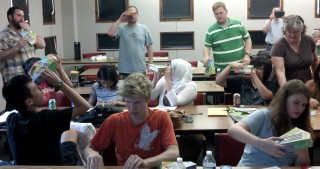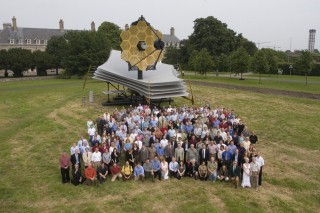Investigating Light: Teachers from seven Chicago high schools work as a team with students to understand the astronomical uses of spectroscopy. This picture was taken at The University of Chicago in July 2013 as part of the NASA-funded All-Stars Program, led by Don York and his staff. The teachers and students are assembling paper spectroscopes created by the Solar Center at Stanford University.
Credit: Julia Brazas
There are a lot of myths about doing science. One is that science is for “somebody else” – not me. Another is that anyone can do science. And then there’s the one that says if you are one of the somebody-else types, then science is easy for you. But that’s not true. A huge fraction of the work of scientists is hard work, even for scientists. The trick is, you have to be so enthusiastic about tackling the work that you’re willing to put the time in to do it. It’s an emotional investment.
You also want to be able to generate enthusiasm in other people. You have to convince people that, if something provides a fundamental advantage, you’re going to find a way to make it work. You’re not going to say, “We won’t do that, because it looks hard.” You persist because after you do something that’s hard for a while, then it’s not so hard anymore. Of course there’s hard and there’s impossible. The impossible you’re not going to do, but if it’s hard, if it provides some really fundamental advantage, then you work to develop the techniques to make it possible. The technical stuff you can learn to do, but to answer interesting questions you have to figure out how to improve upon something to solve your problem. That’s the thinking part, and it can be very hard but very rewarding.
Full-scale model of the James Webb Space Telescope: Northrop Grummon built an actual-size model of the JWST to help them better understand its size, scale, and complexity. The model is made of aluminum and steel, weighs 12,000 lbs., and is 80 feet high x 40 ft wide x 40 ft tall. The model visited a number of sites, including Dublin, Ireland, where it is pictured here in June 2007. On land, the model travels in 2 trucks and it takes 12 people 4 days to assemble it.
Credit: NASA



